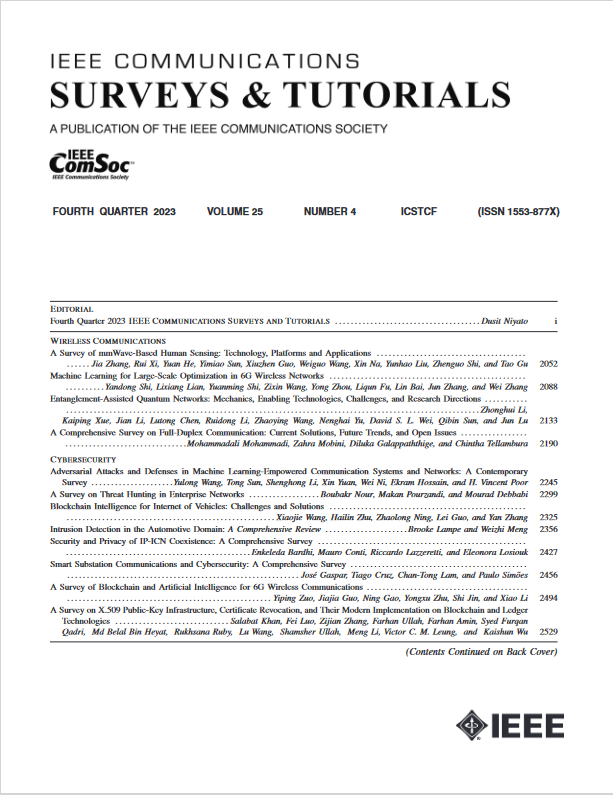Centrality-Based On-Path Caching Strategies in NDN-Based Internet of Things: A Survey
IF 34.4
1区 计算机科学
Q1 COMPUTER SCIENCE, INFORMATION SYSTEMS
引用次数: 0
Abstract
The substantial growth in data volume has led to considerable technological obstacles on the Internet. In order to address the high volume of Internet traffic, the research community has investigated the improvement of Internet architecture by implementing centrality-based caching, which could involve collaborative efforts. Different centrality-based caching strategies have been put forward that allow for different data distribution. These include betweenness centrality, degree centrality, and closeness centrality. Caching provides several advantages in terms of reducing latency, improving scalability, and enhancing data manageability. In addition, this study provides an overview of cache management algorithms based on centrality in the context of Information Centric Networking (ICN), Named Data Networking (NDN), and Internet of Things (IoT). It highlights the advantages and disadvantages of these algorithms and evaluates their performance in a network simulation environment, specifically in terms of cache hit ratio, data retrieval latency, and average hop count. Ultimately, we aim to pinpoint and deliberate on possible research directions for future studies concerning various aspects of centrality-based caching in communication systems.基于 NDN 的物联网中基于中心性的 On-Path 缓存策略:调查
数据量的大幅增长导致了互联网上相当大的技术障碍。为了解决大量的互联网流量,研究社区通过实现基于中心的缓存来研究互联网架构的改进,这可能涉及协作努力。针对不同的数据分布,提出了不同的基于中心性的缓存策略。这包括中间中心性、程度中心性和接近中心性。缓存在减少延迟、提高可伸缩性和增强数据可管理性方面提供了几个优势。此外,本研究还概述了在信息中心网络(ICN)、命名数据网络(NDN)和物联网(IoT)背景下基于中心性的缓存管理算法。重点介绍了这些算法的优缺点,并在网络模拟环境中评估了它们的性能,特别是在缓存命中率、数据检索延迟和平均跳数方面。最后,我们的目标是确定和考虑未来可能的研究方向,涉及通信系统中基于中心性的缓存的各个方面。
本文章由计算机程序翻译,如有差异,请以英文原文为准。
求助全文
约1分钟内获得全文
求助全文
来源期刊

IEEE Communications Surveys and Tutorials
COMPUTER SCIENCE, INFORMATION SYSTEMS-TELECOMMUNICATIONS
CiteScore
80.20
自引率
2.50%
发文量
84
审稿时长
6 months
期刊介绍:
IEEE Communications Surveys & Tutorials is an online journal published by the IEEE Communications Society for tutorials and surveys covering all aspects of the communications field. Telecommunications technology is progressing at a rapid pace, and the IEEE Communications Society is committed to providing researchers and other professionals the information and tools to stay abreast. IEEE Communications Surveys and Tutorials focuses on integrating and adding understanding to the existing literature on communications, putting results in context. Whether searching for in-depth information about a familiar area or an introduction into a new area, IEEE Communications Surveys & Tutorials aims to be the premier source of peer-reviewed, comprehensive tutorials and surveys, and pointers to further sources. IEEE Communications Surveys & Tutorials publishes only articles exclusively written for IEEE Communications Surveys & Tutorials and go through a rigorous review process before their publication in the quarterly issues.
A tutorial article in the IEEE Communications Surveys & Tutorials should be designed to help the reader to become familiar with and learn something specific about a chosen topic. In contrast, the term survey, as applied here, is defined to mean a survey of the literature. A survey article in IEEE Communications Surveys & Tutorials should provide a comprehensive review of developments in a selected area, covering its development from its inception to its current state and beyond, and illustrating its development through liberal citations from the literature. Both tutorials and surveys should be tutorial in nature and should be written in a style comprehensible to readers outside the specialty of the article.
 求助内容:
求助内容: 应助结果提醒方式:
应助结果提醒方式:


